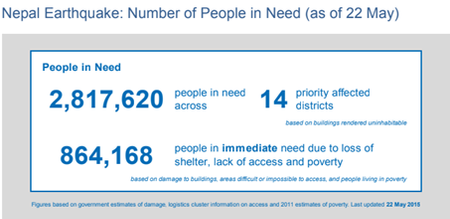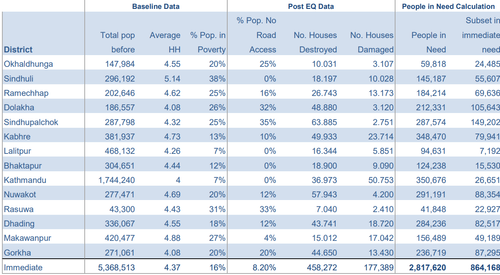...
| Field Example: Nepal Humanitarian Crisis 2015 | |
|---|---|
The Assessment Unit in Nepal worked with the census, damage, vulnerability and access data to define the overall PIN. In their approach, they distinguished between people in need, defined as those who require assistance to be able to rebuild their lives, and people in immediate need due to “loss of shelter, lack of access to essential services and poverty”. The methodology used government statistics of fully and partially damaged houses (houses that cannot be repaired vs houses which are repairable) multiplied by the average household size, overlaid with poverty statistics and road access information. For areas without road accessibility, households with fully and partially damaged houses were all considered in need of immediate assistance, regardless of the poverty threshold, as they were expected to face significant logistical challenges to rebuild their houses during the monsoon. For areas where there was road access, fully and partially damaged households were considered in need of immediate assistance if they were below the poverty line in that district. The affected population was considered to have the most limited capacity to recover from earthquake losses due to their pre-existing financial circumstances and their location. People In Need =(Fully damaged households + Partially damaged households) x Average Household Size People in Immediate Need= PIN x ( Population in Poverty% + Population with no Road Access%) Limitations The limitations of this methodology include the assumption of a uniform impact of destruction on people above and below the poverty line. Poverty may be correlated both with lower impact- as low-rise housing less is likely to be destroyed or easier to rebuild- or higher impact, given a lack of resources to rebuild, repair or resupply. For more information please see the Nepal Earthquake: Number of People in Need. | |
Bottom-Up Approach
The bottom-up approach is used where estimates of population in need are already available but an overall PIN figure still needs to be agreed upon. The bottom-up approach consists of several aggregation rules, which if followed, will eliminate overlap and produce a best estimate of the overall, inter-sectoral number of People in Need.
...

